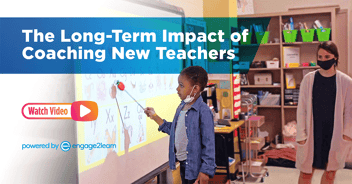The Power of Goal Setting in the Classroom

We all know that incomparable feeling of accomplishment. There is just nothing like it, and once you get a taste of success, there is no going back. Our great successes in life typically don’t happen by accident; they are the result of intentional, focused hard work around an identified goal. Crossing the finish line and achieving your goals is the ultimate benchmark for success in our lives, but first, you have to have a goal!
The same is true for our students. Implementing the best practice of goal setting ensures students are given the opportunity to work towards their goals and get a taste of that satisfying feeling of accomplishing a goal.
Often, teachers tell me they do not want to reward students for “doing something they should already be doing.” While I understand the sentiment – we all work for something, right? We get a paycheck each month because we work, so why should it be any different in the classroom? No, I’m not suggesting students get paid to learn, but why can’t students earn a badge or checkmark each time they work and master a new skill? If it is in the form of a visual, this can help students see where they started and how far they’ve come.
Beginner Goal Setting Tips

If you have not implemented the best practice of goal setting at all in your classroom, here are some things to consider to get started.
Step 1: What are some data points your campus or district is using to measure growth? Is it DRA level, MAP tests, common assessments?
Step 2: Think about how students can use goal-setting to track their growth for that specific data. If it’s weekly assessments, how can you and the students clearly see what standards have been mastered and on which standards students need additional support?
Step 3: Set up a recognition system. What motivates them? Badges, stickers, verbal recognition, or any other incentive for students to work towards will help them achieve their goals.
Master Goal Setting Tips
If you have been setting goals since the beginning of time, then this is a great opportunity for you to reflect.
Step 1: What type of goal-setting are you implementing that is yielding results?
How can you implement goal-setting in areas where students are struggling? For example, ask students to set goals in life ready skills such as collaboration, critical thinking, autonomy, creativity, growth mindset, communication, and professional ethics.
Step 2: How will you recognize and celebrate growth in those areas?
One of my teachers celebrated growth in life ready skills by having students nominate the most “Collaborative Student of the Week.” The student would earn a no-homework pass or five points on a final exam grade.
The Power of Goal Setting in the Classroom

them “I got a new badge –
ask me how?” crowns. She emailed her colleagues and asked that they celebrate her students when they were seen.
Last year, I was coaching a Kindergarten teacher who was struggling to help her students get on grade level for reading. She shared with me that she had 10 students out of 19 below reading level. It was clear to her that letter identification was an issue for most of them, but she was unsure how to best help her students. After a bit of brainstorming together, she decided to create a goal-setting tool where her students would place a sticker on all of the letters they knew so they could see which letters still needed work. For her more advanced students, she included letter sounds so they could also set goals.
After two short months, she only had two students below the reading level. She shared with me the moment she realized her classroom would never be the same. “I stepped out briefly to talk to a teacher, and when I came back in the room, they all had their letter charts pulled out and were helping each other learn their letters or sounds so they could meet their goal for the week. This was when I knew goal-setting works, and I would do it for every class from now on.” This is one of the countless stories relayed to me about the power of goal-setting in addition to my own firsthand experiences. If you haven’t implemented the best practice of goal-setting, I highly encourage you to do so – even if you start very small, because you will see an immediate return on your time investment.
The Significance of Goal Setting in Education
Setting goals in the classroom has numerous benefits for both students and teachers. When students set clear and achievable objectives, it can:
Enhance Motivation: Goals provide students with a sense of purpose and direction, motivating them to work harder and remain focused on their studies.
Promote Self-Reflection: Through goal setting, students learn to assess their strengths and weaknesses, enabling them to make necessary adjustments to improve their performance.
Foster a Growth Mindset: By encouraging students to set realistic goals, teachers have the potential to nurture a growth mindset, where students believe in their ability to improve with effort and dedication.
Develop Time Management Skills: Goal setting teaches students how to prioritize tasks, manage their time effectively, and stay organized.
Coaching Strategies for Educators: As educators, integrating goal setting effectively in the classroom requires guidance and support. Here are some instructional coaching strategies for implementing goal setting practices successfully:
Understanding Student Needs: Encourage teachers to get to know their students individually. By understanding their strengths, weaknesses, interests, and aspirations, teachers can tailor their teaching approach to align with each student's goals.
SMART Goal Setting: Train teachers to guide their students in setting SMART goals - Specific, Measurable, Achievable, Relevant, and Time-bound. This approach helps students create clear and actionable objectives.
Goal Setting Sessions: Conduct regular goal-setting sessions where teachers can facilitate discussions with their students about their progress, challenges, and adjustments to their goals. These sessions foster accountability and keep students on track.
Tracking Progress: Coach teachers to implement systems for tracking student progress. This can include progress charts, journals, or digital tools that allow students to monitor their advancement towards their goals.
Celebrating Achievements: Encourage teachers to celebrate students' successes, no matter how big or small. Acknowledging achievements fosters a positive learning environment and boosts student confidence.
Modeling Goal Setting: Lead by example and showcase goal setting in teacher actions and behaviors. When students witness their teachers setting and achieving goals, it reinforces the importance of the process.
Coaching teachers to use goal setting in the classroom is a powerful approach to create a thriving learning environment. By empowering students to take ownership of their learning journey through goal setting, educators can nurture a growth mindset, improve student motivation, and enhance overall academic achievement. As teachers integrate goal setting into their teaching practices with proper coaching and guidance, they can make a lasting positive impact on their students' lives.
Interested in learning more about how engage2learn’s evidence-based, job-embedded coaching fuels professional growth and engagement aligned to your school district's short- and long-term priorities? Contact us.



